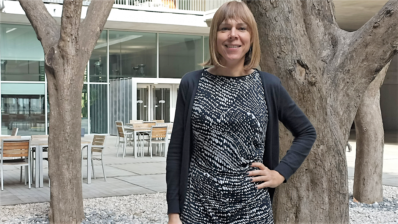David Searls, currently an independent consultor in Philadelphia, USA, retired two years ago from his position as senior Vice President of Bioinformatics in GlaxoSmithKline. Since then, this computer scientist who spent 16 years in academia and 19 years in industry has gone back to his theoretical studies on linguistic analysis of biological sequences. He was invited to the Barcelona Biomedical Research Park (PRBB) last September, and talked to Ellipse about drugs and computers.
What role does bioinformatics play in drug development?
It is an essential step along the way. This is because not only drug discovery, but all biology, has become, since the human genome and the high throughput technologies, an information science. It is very data-intensive, and you need computers to analyse that data.
“Drug discovery, as all of biology, has become an information science, very data-intensive, and you need computers to analyse the data”
David Searls
How is the pharma crisis affecting the pharmaceutical companies?
The pharma industry is indeed in great difficulty at the moment, as costs are increasing while the number of new drugs is going down. One way the large pharmaceutical companies are adapting is by starting to drop some of their therapeutic areas. Fundamentally, R+D is becoming smaller, due to the merging of companies and the reduction of costs. They are also depending more on in-licensing, i.e. buying drugs at different stages of development from smaller biotech companies or from universities. This way the ideas, the basic science and the early testing, are done by smaller companies while Big Pharma does only the last stage, the clinical trials, which is what they are best at. Basically, a more spread out economic model is being created.
Can bioinformatics help with this crisis?
Yes, it can. One of the reasons why the cost of developing drugs is so high is that many of the molecules studied as potential drugs aren’t effective, or have undesired side effects. Better use of the information that predicts interactions between molecules can prevent early failure, since the side effects are usually due to interactions between the drug and proteins other than the target.
Another way bioinformatics can help is in drug repositioning, which is taking a drug that has been approved for one disease, and looking for other uses for it. Bioinformatics helps us find other protein interactions of a specific drug target, and predict which processes that target might be involved in, as well as potential effects. The advantage is that we already have data on the safety of the drug, which is one of the most costly procedures.
“One of the reasons why the cost of developing drugs is so high is that many of the molecules studied aren’t effective or have secondary effects; better prediction of the interactions between molecules, by using bioinformatics, can prevent early failure”
What will be the role of bioinformatics in personalised medicine?
It is already helping to classify diseases via the analysis of transcriptomics, i.e. which genes are activated in each tissue. This allows us to find subtypes of an apparently homogeneous tumour that are susceptible to different drugs. We can then check the expression pattern of the patients to decide which treatment is best for them.
Also, personalised medicine won’t be one drug for one individual, but a combination of drugs for each individual. Again, bioinformatics will help with the prediction of which combinations will be more useful.







